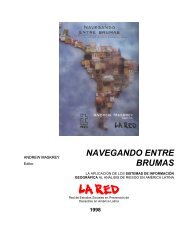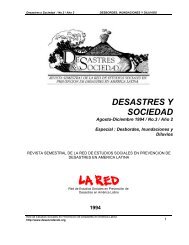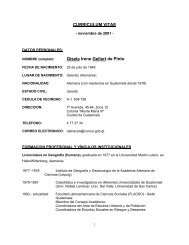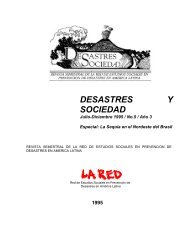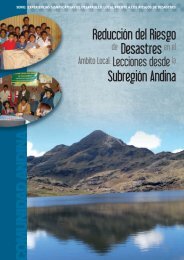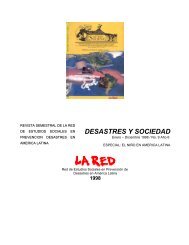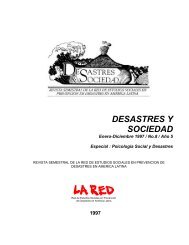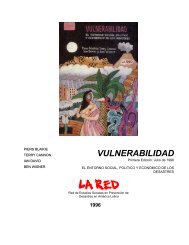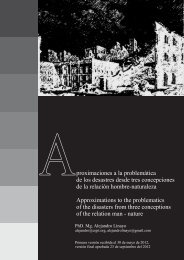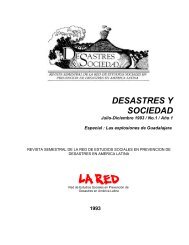Estrategias sociales de prevención y adaptación Social ... - La RED
Estrategias sociales de prevención y adaptación Social ... - La RED
Estrategias sociales de prevención y adaptación Social ... - La RED
Create successful ePaper yourself
Turn your PDF publications into a flip-book with our unique Google optimized e-Paper software.
1<br />
The Shadow of the Past in Dutch Flood<br />
Management: The Rediscovery<br />
and Politicisation of “Best Practices”<br />
Jeroen Warner, Wageningen University, Netherlands<br />
Resumen<br />
<strong>La</strong> gestión holan<strong>de</strong>sa <strong>de</strong>l agua ha llevado un curso errático entre la ambivalencia <strong>de</strong> “más<br />
diques” y “más espacio” para el río. Mientras que por una parte los diques son consi<strong>de</strong>rados<br />
como “tradicionales”, por la otra “más espacio” últimamente significa la reinvención <strong>de</strong> las<br />
dos prácticas locales establecidas que serían mejores candidatos para competir por la etiqueta<br />
<strong>de</strong> “tradicional”: construir sobre montículos así como la i<strong>de</strong>ntificación <strong>de</strong> tierra ganada al<br />
mar con miras a la inundación controlada. No es el conocimiento local sino la contra-experiencia<br />
estratégica la que se ha organizado para contraponerse a las suposiciones <strong>de</strong> los iniciadores<br />
<strong>de</strong>l proyecto Espacio para el Río.<br />
Abstract<br />
Dutch water management has steered an uneasy course between “more dikes” and “more<br />
space for the river”. On the one hand, dikes are now regar<strong>de</strong>d as “traditional”. On the other,<br />
“more space” has meant the reinvention of two established local practices that would be<br />
even better candidates for the “traditional” label: building on mounds, and the i<strong>de</strong>ntification<br />
of calamity pol<strong>de</strong>rs for controlled flooding. It is not local knowledge but rather strategic<br />
counter-expertise that has been strategically mounted to counter the assumptions of Space<br />
for the River project initiators.<br />
Introduction: Reviving “Traditional” Practices<br />
Nobody in their right mind would have planned the Netherlands where it is today - in inhospitable<br />
marshland, a third of its current territory currently below sea level, about half flood<br />
prone, and the majority of its people and economic assets happen to be in that half.<br />
Perhaps not unrelated to the rise of nationalist, anti-mo<strong>de</strong>rnist political parties, the<br />
Netherlands has in the past <strong>de</strong>ca<strong>de</strong> seen the revival of an interest in Dutch history. Local<br />
and national governments together set up a programme to restore historic fortresses, hydraulic<br />
artefacts, revived as cultural heritage by the Dutch Agricultural <strong>de</strong>partment at national<br />
level. A romantic drive for “renaturation” of rivers such as the Maas explicitly harks<br />
back to a romantic i<strong>de</strong>al of the “untouched” river, such as the French river Allier today.<br />
Controlled flooding revives a long-standing practice. Recent years have seen a revival of<br />
Holland’s most famous water export, dikes.<br />
These i<strong>de</strong>as resonate internationally because it was the Dutch who converted the world<br />
to land reclamation: for example, they reclaimed land in East Anglia in the 1630s, helped<br />
Japan control its floods, and after Hurricane Katrina in Summer 2005, the Dutch were first<br />
to be called on, like mercenary water fighters to calculate dikes, Water boards are promoted<br />
25



